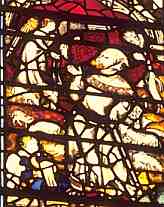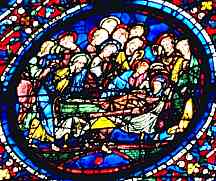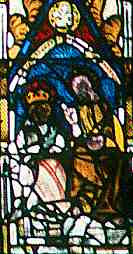





If you are looking at this page without frames, there is more information about medieval writing to be found by going to the home page (framed) or the site map (no frames).
| New Testament Apocrypha (3) | ||||
| It is unfortunate but true that Christianity had its birth in a male dominated society, and whatever roles women may have had in the practice of the Jewish cult of Jesus, the writers and editors of the official canon of the New Testament gave scant commentary on the roles of women in the Christian story. References to women are brief, disconnected and enigmatic; an adulteress here, a bearer of ointment there. The character of Mary Magdalene was a medieval compilation from scattered references to incidents involving women, which are not explicitly connected in the Bible. Her function in the church was to promote the value of recanting sin and being forgiven. |  |
|||
| An image of Mary Magdalene above a poem which emphasises her redemption from sin, in the 12th century Melissande Psalter (British Library, Egerton 1139, f.210), by permission of the British Library. | ||||
| Even Mary, the mother of Jesus, who conceived the son of God and gave birth as a virgin, as prophesied in Isaiah (7:14), and raised him to die on the cross, gets very cursory treatment in the official gospel accounts. She is a necessary vehicle, not a character in her own right. Even in the early days, there must have been some writers who felt that she required more detailed treatment, as the Protoevangelium of James, as well as two other texts, contains the full story of the courtship and marriage of her parents, Joachim and Anna, and her own conception, birth, and the events of her life up to an including the beginning of the gospel stories. These also eventually appear in the Golden Legend, coinciding with a period of enhancement of the status of Mary and the virtues she embodies within the church. Images from the apocryphal stories appear, along with the multitudes of gospel based images and purely iconic representations, to make her the most profilically represented of all the saints. The universal mother will not be denied. | ||||
| Imagery from the story of Joachim and Anna was used to emphasise the increasing significance that the church placed on Mary herself having been immaculately conceived, raising her to a status way beyond that of all the other saints. |  |
|||
| Joachim receives the news of his wife's conception from an angel, while out tending his sheep, in a 15th century stained glass window in York Minster. | ||||
| Apocryphal texts also told of the life of the Virgin after the death and resurrection of Christ, and of her death, or rather, as it is termed, dormition, as she was deemed not to have died in the normal way, but was taken bodily to heaven by angels. | ||||
 |
||||
| The death of the Virgin, surrounded by the haloed figures of the apostles, as depicted in a roundel in the 13th century windows of Chartres cathedral. | ||||
 |
The funeral of the Virgin, as portrayed in a 15th century wall painting in the parish church of Pickering, Yorkshire. | |||
| The coffin is borne on the shoulders of the apostles. The figure on top represents the story of a Jew who jumped on the coffin, but was miraculously held fast there until he begged for forgiveness. Alas, the medieval church was not averse to anti-Semitic propaganda. | ||||
 |
||||
| A kind of two panel strip cartoon showing the death of the Virgin, and her body being lifted up by angels, from a tympanum on the north porch of Chartres cathedral. | ||||
| The end of this journey was the coronation of the Virgin in heaven, which is found depicted in stained glass and triumphantly carved on the tympana of major church doors, as is the image of the Virgin reigning in majesty in heaven. The apocryphal stories elevated her from a necessary player in the drama to a starring role in the pantheon of saints. The example at right is a small panel, and rather battered, but it represents the many representations in the ordinary little parish churches around Christendom. Christ's nimbus, his elevated hand and the crown on the head of the Virgin can be clearly made out among the jumble of battered and restored glass. |  |
|||
| Coronation of the Virgin as depicted in a 15th century stained glass panel in the east window of the church of St Michael-le-Belfry, York. | ||||
If you are looking at this page without frames, there is more information about medieval writing to be found by going to the home page (framed) or the site map (no frames). |
||||